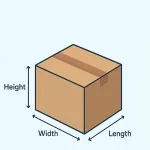Accurate box measurements keep packaging neat, cost-efficient, and professional. iPackU helps businesses understand how length width height define structure, volume, and shipping cost of every package.
What Does Length, Width, and Height Mean?
Length describes the longest side at the base of a box. Width measures the shorter side of that same base. Height, sometimes called depth, extends upward from base to top. Together, they define a box’s three-dimensional space.
At iPackU, we teach the standard order Length × Width × Height (L × W × H) because it ensures consistency when quoting sizes or designing custom packaging.
Why Correct Order Matters in Packaging
Keeping measurements in the right sequence prevents confusion across production and logistics. A reversed order may result in wrong-sized cartons, wasted material, or miscalculated freight.
Carriers like FedEx and UPS rely on the same order when determining dimensional weight, so an error directly changes shipping charges. Clear measurement language keeps every stakeholder aligned—supplier, shipper, and client alike.
How Length Width Height Affect Shipping and Design
A larger length influences layout and print panels. Width decides stability and how products line up inside. Height determines stackability and protective spacing.
At iPackU, our engineers adjust all three variables before printing or die-cutting to match product safety and presentation goals. Balanced proportions improve both durability and unboxing appearance.
How To Measure a Box Accurately
- Place box on flat surface.
Keep the box in its normal upright position. - Measure length.
Use a rigid tape; record the longest base edge. - Measure width.
Note the shorter base edge next to the length. - Measure height.
Measure vertically from base to top edge.
Always record values in order — L × W × H — and round to the nearest millimeter or 1/8 inch for precision. Re-check each number before printing or placing orders. Small errors shift total volume and increase cost.
What If Order Seems Different?
Sometimes you’ll see H × W × L or W × D × H in technical drawings. Context decides that sequence.
For vertical boxes, designers may list Height first because orientation changes reference point. Furniture manufacturers often use Width × Depth × Height since “depth” replaces length.
No matter the notation, clarify orientation before confirming production. iPackU always communicates dimensions in standard L × W × H to keep specifications uniform across projects.
How To Calculate Box Volume
Volume tells how much space a box encloses. The formula stays simple:
Volume = Length × Width × Height
Example: a carton measuring 16 in × 12 in × 12 in.
Volume = 16 × 12 × 12 = 2,304 cubic inches.
That number drives freight class and stacking efficiency. Accurate cubic size avoids excess packaging and reduces shipping charges. At iPackU, our dimensional calculator automates this step so teams can compare multiple box options quickly.
Common Mistakes When Recording Dimensions
- Mixing order: Writing W × L × H instead of L × W × H causes confusion.
- Ignoring outer vs inner size: Measure outside when shipping, inside when designing inserts.
- Using flexible tape: Soft tapes curve and distort edges; always use rigid metal or laser measure.
- Skipping recheck: A single wrong digit alters cost models.
Avoiding these errors keeps packaging consistent and compliant across manufacturing lines.
Why Precise Measurement Matters for Brands
E-commerce sellers rely on reliable box dimensions for inventory accuracy and freight budgeting. Small-batch brands choose iPackU custom sizes to fit product profiles perfectly, saving filler material and improving sustainability scores.
Correct length width height alignment ensures print layouts remain centered, logos stay visible, and customers receive neat packages without crushed edges.
FAQ: Length Width Height Clarified
What’s the correct order for L × W × H?
Always record measurements as Length × Width × Height (L × W × H). This standard keeps packaging consistent during production and shipping.
What does W × D × H mean?
It means Width × Depth × Height. Depth acts as length in industries like furniture or storage design.
How do you calculate L × W × H?
Multiply the three dimensions together to find volume in cubic units. For instance, a 10 × 8 × 6 box has 480 cubic inches of space.
Why is knowing volume important?
It controls dimensional weight charges and helps choose the most efficient box for safe delivery.
Does breadth mean width?
Yes. Breadth and width refer to the same horizontal dimension in most contexts.
Key Takeaways by iPackU
- Always list measurements as L × W × H.
- Re-measure before approval or mass production.
- Keep a clear distinction between inner and outer sizes.
- Use precise tools – rigid tape or digital caliper.
- Record measurements consistently across departments.
Accurate dimensions protect product integrity, enhance brand image, and optimize logistics. iPackU ensures each packaging project follows global measurement standards so every shipment arrives safely and fits perfectly.






